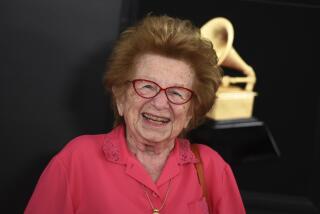Recognizing the pioneers of safe sex
- Share via
“It’s never too late to start having safe sex,” asserts writer and AIDS activist Richard Berkowitz. And he should know.
That’s because more than 25 years ago, during the early days of the AIDS crisis, Berkowitz, a gay, HIV-positive, former S&M; hustler, actually invented the notion of safe sex, along with Joseph Sonnabend -- a controversial but devoted virologist who often took on the scientific establishment -- and late singer-songwriter Michael Callen.
Berkowitz’s life and landmark achievement are chronicled in Daryl Wein’s Outfest Award-winning documentary “Sex Positive,” which opens Friday.
If you’ve never heard of Berkowitz or never knew how safe sex began, he says it’s no accident. “The reason the invention of safe sex was written out of history is because the people who took control of the epidemic when AIDS began within the gay community were very concerned about the shift to the right under [then-President] Reagan,” said the Manhattan-based Berkowitz, 53, during a recent visit to Los Angeles. “They were afraid that if we spoke too graphically about what was going on with gay men’s sexual behavior, people wouldn’t have sympathy and it would threaten immediate funding for research and treatment.”
--
Medical mentor
In 1982, Berkowitz and Callen were introduced by Sonnabend, their mutual doctor. Guided by Sonnabend’s insights from, among other things, his work at a private Greenwich Village STD clinic, the pair co-wrote an article for the influential, now-defunct gay newspaper the New York Native. Contrary to prevailing views, their piece posited that it wasn’t just a single viral infection that was suddenly killing gay men but that an accumulation of promiscuity and drug use were compounding the risk factors.
The pioneering article, written before the actual discovery of HIV, launched Berkowitz’s and Callen’s careers as AIDS activists but also angered the gay community, whose majority branded the pair as self-hating and “sex negative.”
“I was very sympathetic to how difficult it was for gay men of my generation to accept that this former freedom that we were all celebrating was actually doing us great harm,” said the passionately verbal, intensely well-informed Berkowitz.
The next year, Berkowitz and Callen (under Sonnabend’s scientific supervision and with editorial assistance from Callen’s life partner, Richard Dworkin) co-authored “How to Have Sex in an Epidemic: One Approach,” the first document to identify and advocate “medically safe sex,” which encouraged condom use along with such practices as limited oral sex and creative mutual fantasy to prevent the spread of sexually transmitted diseases. According to Berkowitz, who remains healthy today thanks to a longtime regimen of responsible behavior and prophylactic medication, their self-distributed, 40-page manual “took on a life of its own.” He added, “Within a few years, the concept of safe sex was pretty much established around the country.”
--
‘Safe Sex’: his story
In 2003, after two decades of activism, Berkowitz wrote his autobiography, titled “Stayin’ Alive: The Invention of Safe Sex.” It was this compelling memoir that would inspire Wein, a young, heterosexual filmmaker Berkowitz met at a Passover Seder in 2006, to make the activist his next documentary subject.
“I was immediately intrigued by the fact that Richard was a retired sex worker,” recalled Wein, in a phone call from Manhattan. “But when I read his book, I was blown away. It was a history I didn’t know anything about. The fact that I’d never thought about how safe sex arrived in America was shocking to me. I just dove right in.” A year’s worth of filmed interviews with Berkowitz followed.
The Connecticut-bred Wein, 25, who wasn’t yet born when Berkowitz and company first identified safe sex, admits that his learning curve on the topic was steep. “I had so much to take in, so much to grapple with,” Wein said. The early years of AIDS “has such a convoluted history that it was really difficult to find information online and in the library about it other than what I had from Richard’s archives, which, fortunately, were quite immense.”
Ultimately, all of the archival material seen in the micro-budgeted “Sex Positive” came from Berkowitz’s personal collection, which included hundreds of hours of prerecorded videocassettes of 1980s-era news broadcasts and cable TV programming, as well as revealing footage and snapshots of Berkowitz’s actual S&M; sessions.
--
Differing views
While Wein was comfortable incorporating these graphic images -- as well as the more candid specifics of Berkowitz’s sex worker experiences -- into the finished film, Berkowitz was less sanguine. “It was a battle,” said the activist. “From the start, Daryl wanted me to talk about being an S&M; hustler and what I did. I only wanted to talk about it vis-a-vis what I wanted a new generation -- one that was denied effective safe sex education under the last eight years of George Bush -- to understand about what’s been lost about safe sex history.”
“It never really felt much like a battle,” countered Wein. “For the most part, we were always on the same page.”
Wein added, “My generation is so used to seeing graphic material, it takes a lot to shock us. I wasn’t trying to shock anyone though. I just put in as much as was needed to tell the story.”
No matter, Berkowitz has made peace with his cinematic portrait. “Who I was and what I know is what helped me discover safe sex and save lives,” he concluded. “That’s what’s most important.”
--


